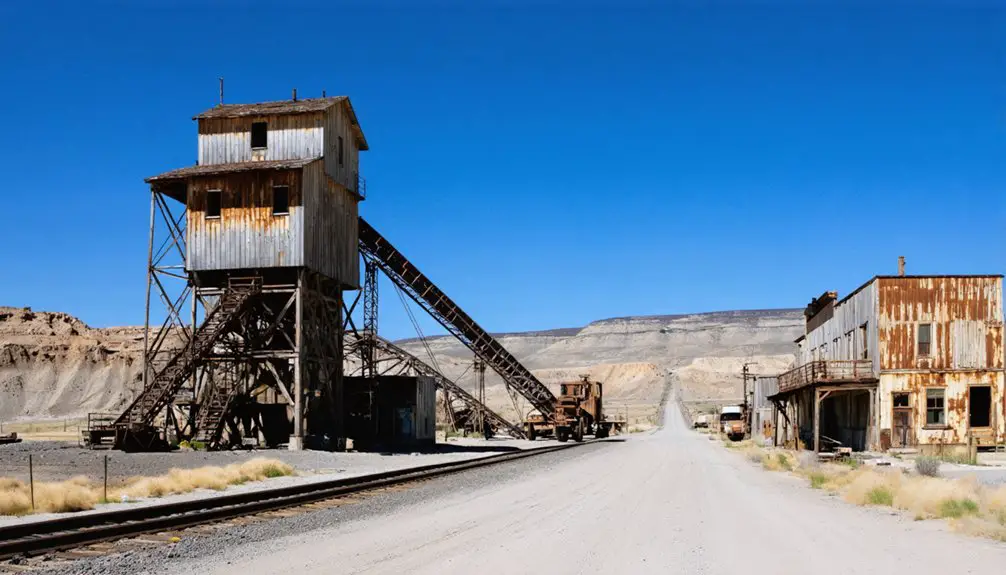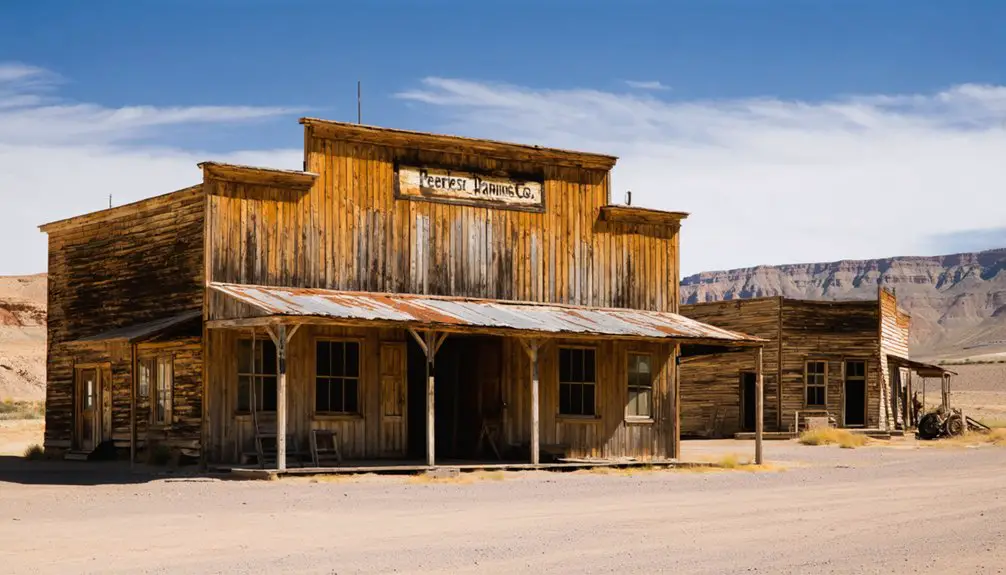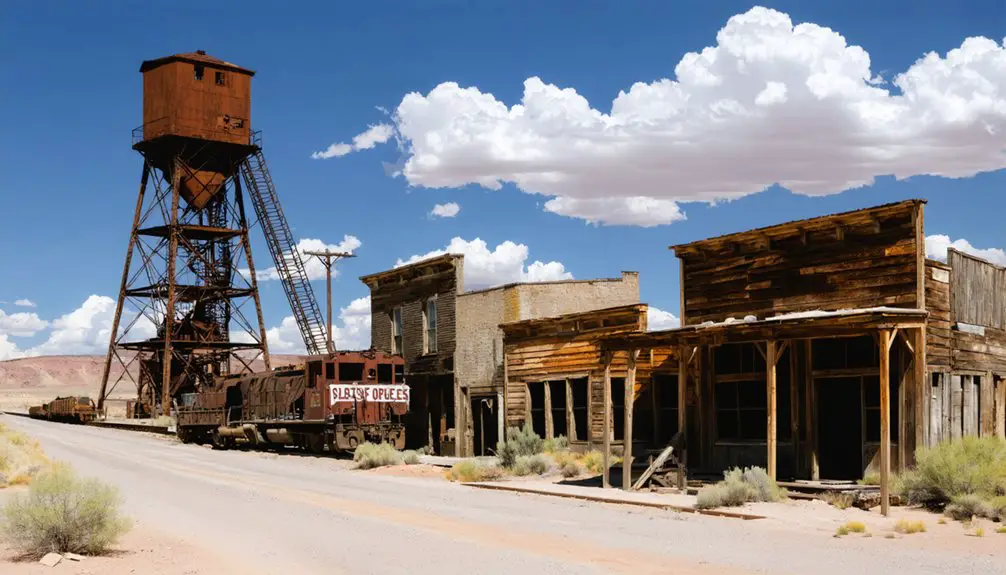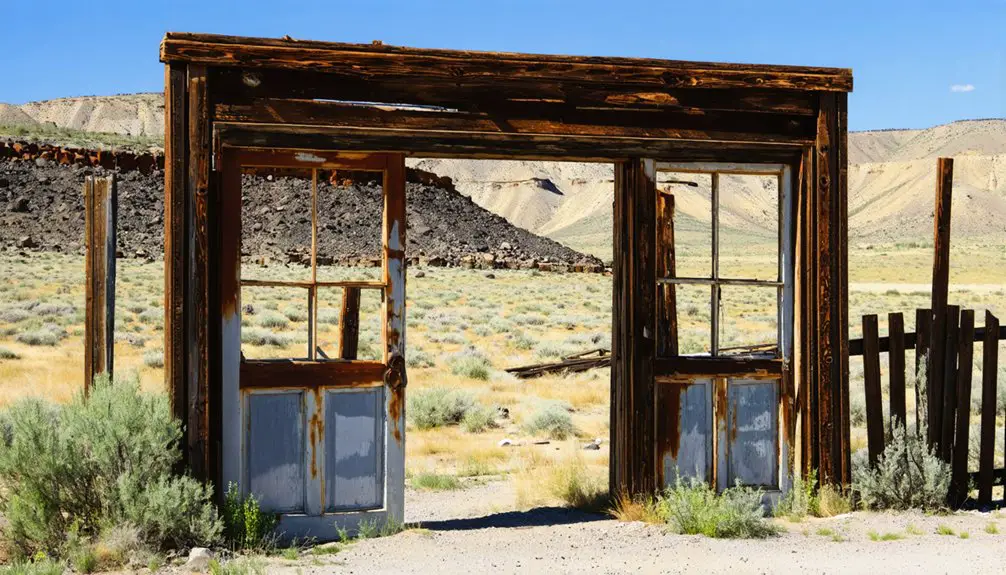You’ll discover Peerless, Utah as an abandoned coal mining town nestled in Spring Canyon at 6,000 feet elevation, approximately 3 miles west of Helper. Established in 1916 by the Sweet brothers, it flourished during World War I with peak production of 2,000 tons of coal daily. The company town, complete with modern homes and essential services, supported 300 residents until its closure in 1953. The site’s rugged terrain and remaining infrastructure tell a compelling story of America’s industrial past.
Key Takeaways
- Peerless, Utah was established in 1916 as a coal mining town in Spring Canyon, located 3 miles west of Helper city.
- The town featured modern infrastructure including 20 company-built homes, aerial tramways, and a McNally-Pittsburgh Steel tipple processing 400 tons hourly.
- At its peak, Peerless had approximately 300 residents and produced 2,000 tons of coal daily during World War I.
- The community operated under complete company control, with company housing and mandatory shopping at the company store.
- Peerless became a ghost town after the mine’s final closure in 1953 due to depleted coal reserves and declining profitability.
The Birth of a Mining Dream
While many mining ventures emerged in early 20th century Utah, Peerless began its journey in 1916 when William H. and Charles N. Sweet purchased 440 acres to establish coal mining operations.
Their vision for this mining heritage site quickly materialized as they constructed essential infrastructure, including a gravity tramway and tipple by the railroad spur.
Early mining pioneers swiftly transformed raw land into an operational site through strategic placement of vital transportation and processing facilities.
You’ll find that within a year, the Sweets sold their interest to the Peerless Coal Company, led by James Murdoch and Ezra Thompson.
This corporate shift brought experienced leadership, including former state coal mine inspector Robert Howard as superintendent.
By 1918, the mine was shipping coal via the Denver & Rio Grande Railroad.
The company invested heavily in community development, building twenty modern homes focused on providing workers with sanitary and permanent housing.
Location in Carbon County’s Spring Canyon
You’ll find Peerless perched at 6,000 feet elevation on the north side of Spring Canyon, approximately 3 miles west of Helper city in Carbon County, Utah.
The ghost town’s position 2½ miles west of Spring Canyon proper places it upstream within the historic Spring Canyon coal mining district.
The rugged terrain surrounding Peerless features steep cliffs and mountainous paths characteristic of this mining region, which influenced the town’s development and mining operations. The town supported mining operations daily, producing up to 2,000 tons of coal at its peak during World War I.
The nearby hamlet of Storrs lies 3½ miles west, following the winding canyon path through the district.
Geographic Setting and Elevation
Situated within Carbon County’s Spring Canyon, the ghost town of Peerless perches approximately 3 miles west of Helper, Utah, at an elevation of 6,000 feet above sea level.
You’ll find this historic mining community nestled among steep cliffs and rugged terrain, where geographical challenges shaped the town’s development and mining operations.
The elevation impact extends beyond mere altitude, as the site’s positioning required innovative solutions for coal transport, including the construction of gravity tramways to navigate the challenging topography.
The mountainous setting places Peerless within a network of similar mining communities, including Storrs and Spring Canyon proper, all sharing the valley’s distinctive features.
The terrain’s natural constraints influenced everything from building placement to infrastructure development, ultimately contributing to the town’s eventual abandonment.
Canyon Access and Terrain
Entering Spring Canyon, visitors traverse the primary access route of Spring Canyon Road, which extends westward from Helper through increasingly rugged terrain.
You’ll pass under Jacob’s Bridge before encountering canyon exploration opportunities amid steep cliffs and remnants of historical mining operations. Ancient Fremont Indian rock art can still be seen on some canyon walls. A parking area with pit toilets at 2.7 miles provides a strategic viewpoint of the surrounding landscape. The old railroad grade that once transported coal runs parallel to the main road.
The rugged terrain challenges become apparent as you approach Peerless, situated approximately 3 miles from Helper.
The site’s layout spans both the canyon floor and adjacent cliffs, where mining infrastructure once transported coal via gravity tramways. The narrow valley features scattered boulders, mining debris, and vertical rock faces that attract climbers.
Historical structures, including remains of about 30 houses and various community buildings, dot the mountainous landscape.
Distance From Helper City
The historic ghost town of Peerless lies precisely 3 miles west of Helper, Utah, at coordinates 39°41′23″N latitude and 110°54′24″W longitude.
Modern-day visitors can locate the site using UTM coordinates 12S 508003.14617544 for precise navigation.
Situated at an elevation of 6,447 feet in Carbon County’s Spring Canyon area, this ghost town’s proximity to Helper played a significant role in its mining operations and economic development. Similar to the luxury automobiles produced by the Peerless Motor Company in the early 1900s, the town of Peerless was known for its high-quality coal production.
You’ll find these key Helper connections throughout Peerless history:
- The Denver and Rio Grande Western Railroad provided essential transportation of coal from Peerless to Helper’s distribution hub.
- The short distance enabled efficient supply lines and labor movement between the two communities.
- Helper served as the primary support center for Peerless’s mining operations until the town’s eventual abandonment.
Today, you can still trace the historic routes that once connected these two important coal mining communities.
Building the Mining Infrastructure
As mining operations commenced in Spring Canyon, Peerless established sophisticated infrastructure to tackle the region’s challenging terrain.
You’ll find evidence of innovative mining technology in the McNally-Pittsburgh Steel tipple, constructed in 1929, which could process 400 tons of coal per hour. The infrastructure development included aerial tramways that transported coal from mine portals high on canyon walls down to the tipples adjacent to railroad lines.
At 6,300 feet elevation, the New Peerless mine drove tunnels at 30-degree downward inclines to reach coal seams up to 2,300 feet below the Price River level. The two coal seams discovered were exceptionally thick, measuring 24 feet and 16-18 feet respectively. The mine’s coal preparation plant could handle up to 5,000 tons daily.
The operation connected to both the Utah Railway and D&RGW railroad systems, with dedicated rail yards linking to the D&RGW mainline for efficient coal distribution.
Peak Production Years and Wartime Boom

During World War I, you’ll find Peerless mine reached its zenith with daily coal production of 2,000 tons to meet heightened military demands.
The operation’s success stemmed from lucrative contracts that shipped coal throughout the Pacific Northwest, including Idaho, Washington, Oregon, and even the Hawaiian Islands.
You can trace how this wartime boom enabled the mine to eliminate its $400,000 bonded debt by 1920, positioning the operation for sustained growth.
Military Demands Drive Growth
While America’s involvement in World War I accelerated industrial production nationwide, Peerless experienced unprecedented growth as daily coal extraction reached 2,000 tons to meet military and manufacturing demands.
The military impact transformed the town’s economy, driving rapid expansion of mining operations and infrastructure development to sustain heightened production levels.
You’ll find these key developments marked Peerless’s wartime economic growth:
- Mining operations expanded dramatically to meet military energy requirements
- Local infrastructure and support services grew to accommodate increased production
- Peak extraction rates strained existing coal seams, leading to reduced minable reserves
This surge in production proved temporary, however, as post-war shifts toward alternative fuel sources and declining industrial demand ultimately challenged the town’s long-term sustainability.
Daily Two Thousand Tons
The wartime demands of World War I propelled Peerless Mine to its unprecedented peak production of 2,000 tons daily, yielding approximately 1.5 million tons between 1917 and 1930.
You’ll find that this remarkable output emerged from the A seam, despite its relatively thin coal deposits, through intensive mining techniques that maximized extraction during the war effort.
When you examine the economic shifts that followed the war, you’ll notice how changing energy markets and reduced industrial demand impacted operations.
Coal prices plummeted from $3.35 to $2.00 per ton, while competition from oil and natural gas grew stronger.
Though Howard & Turner later introduced cost-saving technologies and modern machinery in the 1930s, production never again reached these wartime heights, ultimately leading to the mine’s closure in 1953.
Pacific Northwest Coal Contracts
As Pacific Northwest coal production surged to unprecedented levels, Washington state’s output doubled from 2 million tons in 1900 to 4 million tons by 1918, marking the region’s peak production era.
You’ll find this growth reflected dramatic market shifts in coal contracts throughout the Pacific Northwest.
- Your regional coal industry faced significant upheaval as California markets declined, with San Francisco-bound exports dropping from 85% to 35% by 1890.
- You’ll notice World War II temporarily boosted demand during 1939-1945, creating a brief resurgence in mining activity.
- Your local production eventually succumbed to competition from Utah and Wyoming coal, which dominated Washington’s market by the 1970s.
This transformation fundamentally reshaped the Pacific Northwest’s energy landscape, as hydroelectric power increasingly replaced coal for electricity generation.
Life in a Company-Owned Coal Town

Located high in Utah’s coal country, Peerless exemplified life in a prototypical company-owned mining town during the early 20th century.
You’d find yourself living under complete company control, with all aspects of daily life centered around coal production. The company owned the thirty houses where you and your fellow miners lived, and you’d have no choice but to shop at the company store.
While you’d have access to essential services like a school for your children and a post office, social stratification was evident. As a miner, you wouldn’t be welcomed at the officials’ clubhouse.
You’d work alongside roughly 150 other miners, managing challenging coal seams under Superintendent Robert Howard’s oversight, while your family joined the tight-knit community of 300 residents who called this mountain town home.
The Sweet Brothers’ Legacy
Behind Peerless’s establishment stands the enterprising vision of William H. and Charles N. Sweet, whose strategic acquisition of 440 acres in 1916 marked the beginning of Spring Canyon’s mining heritage.
You’ll find their impact reflected in three significant achievements:
- Their development of essential infrastructure, including the gravity tramway and tipple, laid the foundation for successful coal extraction.
- Their quick sale to Peerless Coal Company in 1917 attracted substantial investment, transforming undeveloped land into a thriving mining community.
- Their pioneering spirit opened up previously overlooked territory, creating economic opportunities that supported 300 residents at its peak.
The Sweet brothers’ impact resonates through time, as their initial vision turned marginal land into Utah’s first Spring Canyon coal camp, though today only foundations and filled mine shafts remain to tell their story.
Economic Challenges and Technological Changes

Despite initial success and peak production of 2,000 tons per day during World War I, Peerless faced mounting economic challenges that would ultimately seal its fate.
You’ll find that the town’s economic sustainability was severely compromised by depleting coal reserves, with thin seams and burned coal reducing both quality and profitability. By 1930, production costs had soared while output dwindled.
Though Howard & Turner introduced new mining technology in 1931, and operations shifted from rail to truck shipping in 1932, these adaptations couldn’t overcome the fundamental resource depletion.
The mine’s sporadic operation after World War II, despite technological improvements, demonstrates how market forces and dwindling coal reserves proved insurmountable.
The final closure in 1953 marked the end of numerous attempts to maintain profitable operations through modernization and management changes.
Final Days of Mining Operations
While the Peerless Coal Company‘s initial bankruptcy in 1931 marked a turning point, the mine’s final chapter would unfold through a series of small-scale operations spanning two decades.
You’ll find that despite technological advances and shifts from rail to truck transport, the mine’s final operations struggled against mounting economic pressures and declining coal seam productivity.
Here’s how the final phase played out:
- Howard & Turner introduced mechanical mining methods in 1931 to reduce costs.
- Peerless Sales Company acquired the operation in 1932 for $16,000, focusing on low-seam extraction.
- Production steadily declined through the late 1930s until the mining closure in March 1953.
The mine’s remaining assets were sold off, and the last residents departed, transforming Peerless into the ghost town you can visit today.
Ghost Town Remnants Today

Today’s visitors to Peerless will encounter a haunting collection of structural remnants scattered across the canyon landscape, including the deteriorating shells of approximately 30 former houses, a schoolhouse, store, post office, pool hall, and clubhouse.
The ghost town architecture reveals skilled stone masonry work, with mortared walls still standing as evidence of the town’s mining history.
You’ll find widespread tailings piles and industrial remnants, including tipple foundations where coal was once sorted. Mining equipment ruins and gravity tramway traces dot the hillsides, while environmental scars from extensive coal extraction remain visible throughout the canyon.
Though most wooden structures have collapsed, stone foundations and partial walls persist, offering glimpses into this once-thriving community.
Exercise caution when exploring, as unstable structures and toxic minerals pose safety risks.
Frequently Asked Questions
What Happened to the Residents of Peerless After the Mine Closed?
You’ll find that life after mining meant dispersal, as residents relocated to nearby towns like Helper or left the region entirely, seeking new employment and community after Peerless’s total abandonment.
Were There Any Major Mining Accidents or Disasters in Peerless?
Yes – you’ll find records show a devastating gas explosion at New Peerless Mine in 1930 killed five miners. Mining safety reports confirm poor ventilation and equipment sparks caused this major accident.
What Was the Average Wage for Miners Working in Peerless?
While you’d think mining wages were lucrative back then, you’d earn about $6.46 to $7.03 per day at Peerless, working 8-9 days biweekly, with an economic impact of roughly 82-92 cents hourly.
Is It Legal to Visit and Explore Peerless Ghost Town Today?
You can legally explore this ghost town since it’s on BLM public land, but you’ll need to follow ghost town regulations, including no artifact removal, while exploring safely on accessible areas.
Did Native Americans Inhabit the Spring Canyon Area Before Mining Began?
Like footprints in ancient sand, you’ll find abundant evidence that Native Americans thrived in Spring Canyon long before mining. Their rich Native Heritage is confirmed through Cultural Artifacts spanning thousands of years.
References
- https://en.wikipedia.org/wiki/Peerless
- https://kids.kiddle.co/Peerless
- https://jacobbarlow.com/2020/02/25/peerless-utah/
- https://www.legendsofamerica.com/peerless-utah/
- https://utahrails.net/utahcoal/peerless.php
- https://www.uen.org/utah_history_encyclopedia/m/MINING.shtml
- https://utahrails.net/mining/brewster.php
- https://mapcarta.com/23440536
- http://www.expeditionutah.com/forum/index.php?threads/the-ghosts-of-spring-canyon.7553/
- https://en.wikipedia.org/wiki/Spring_Canyon



